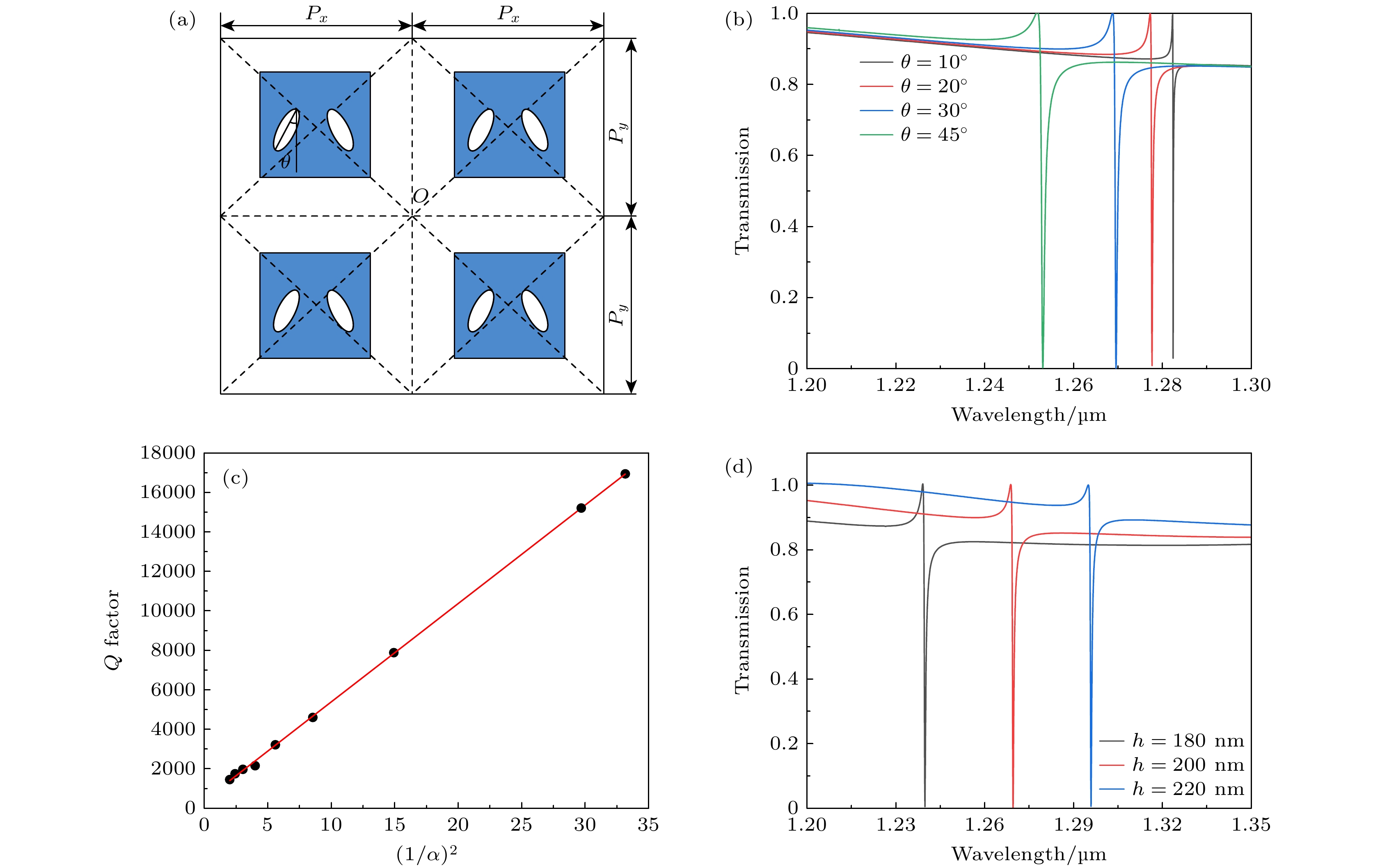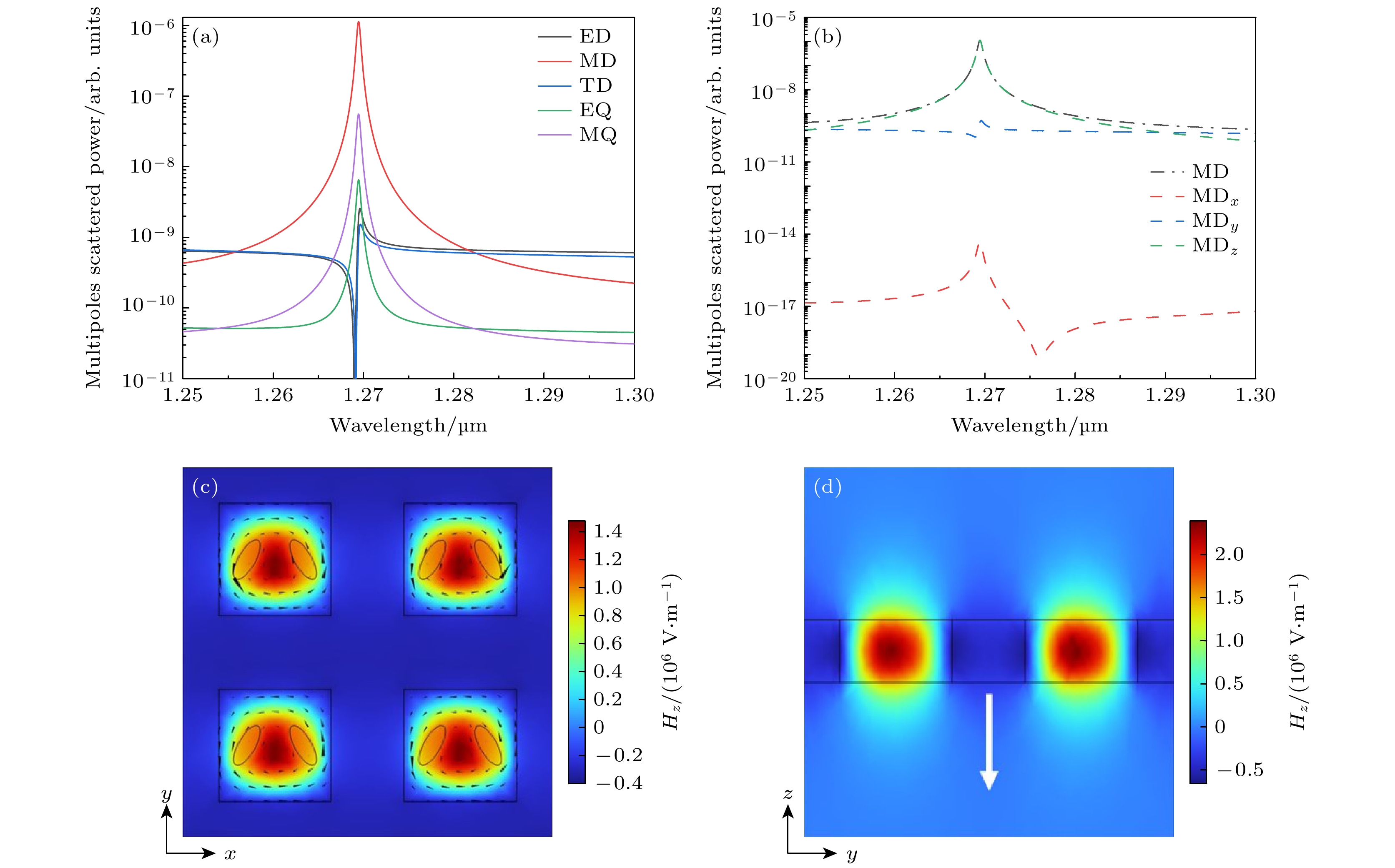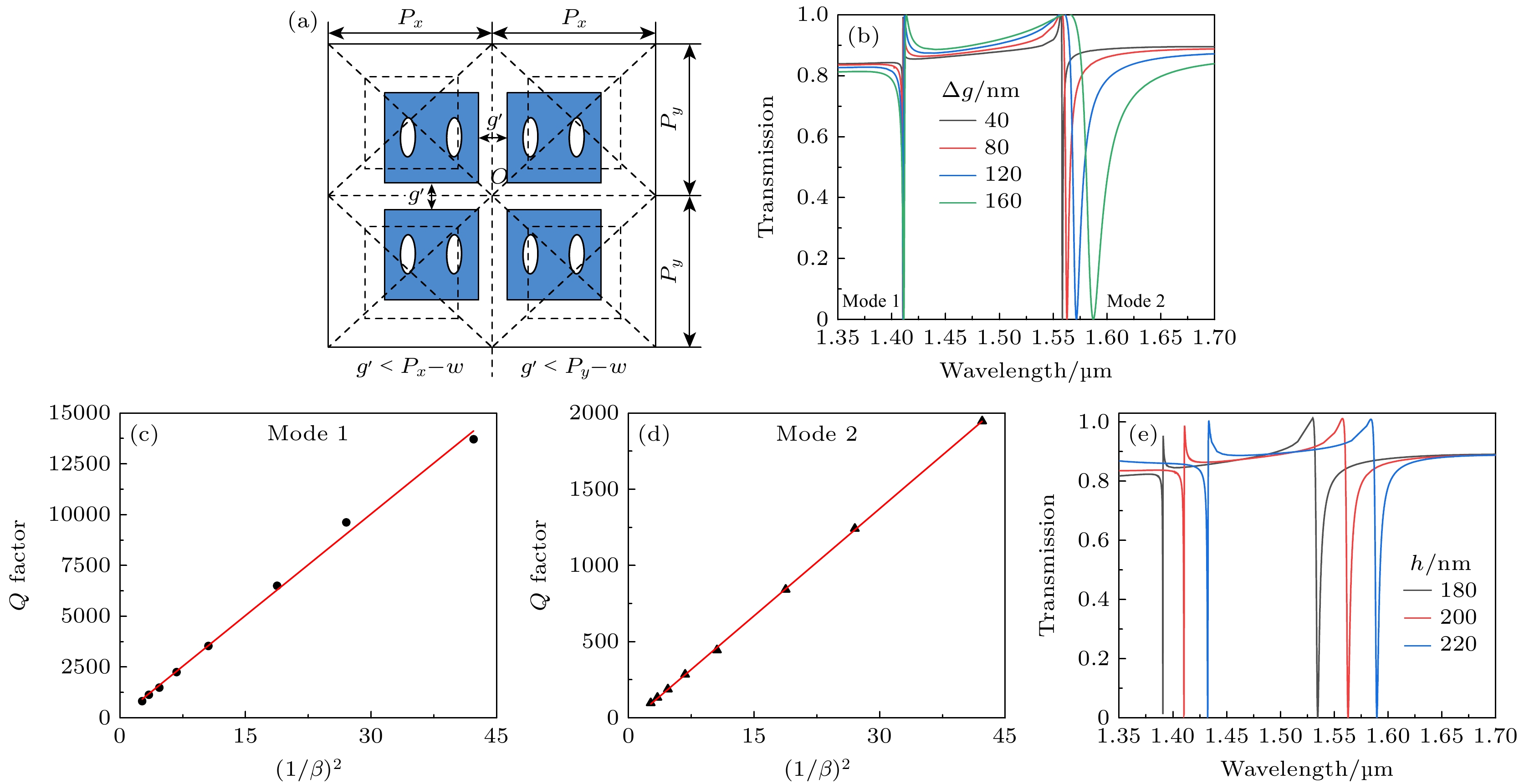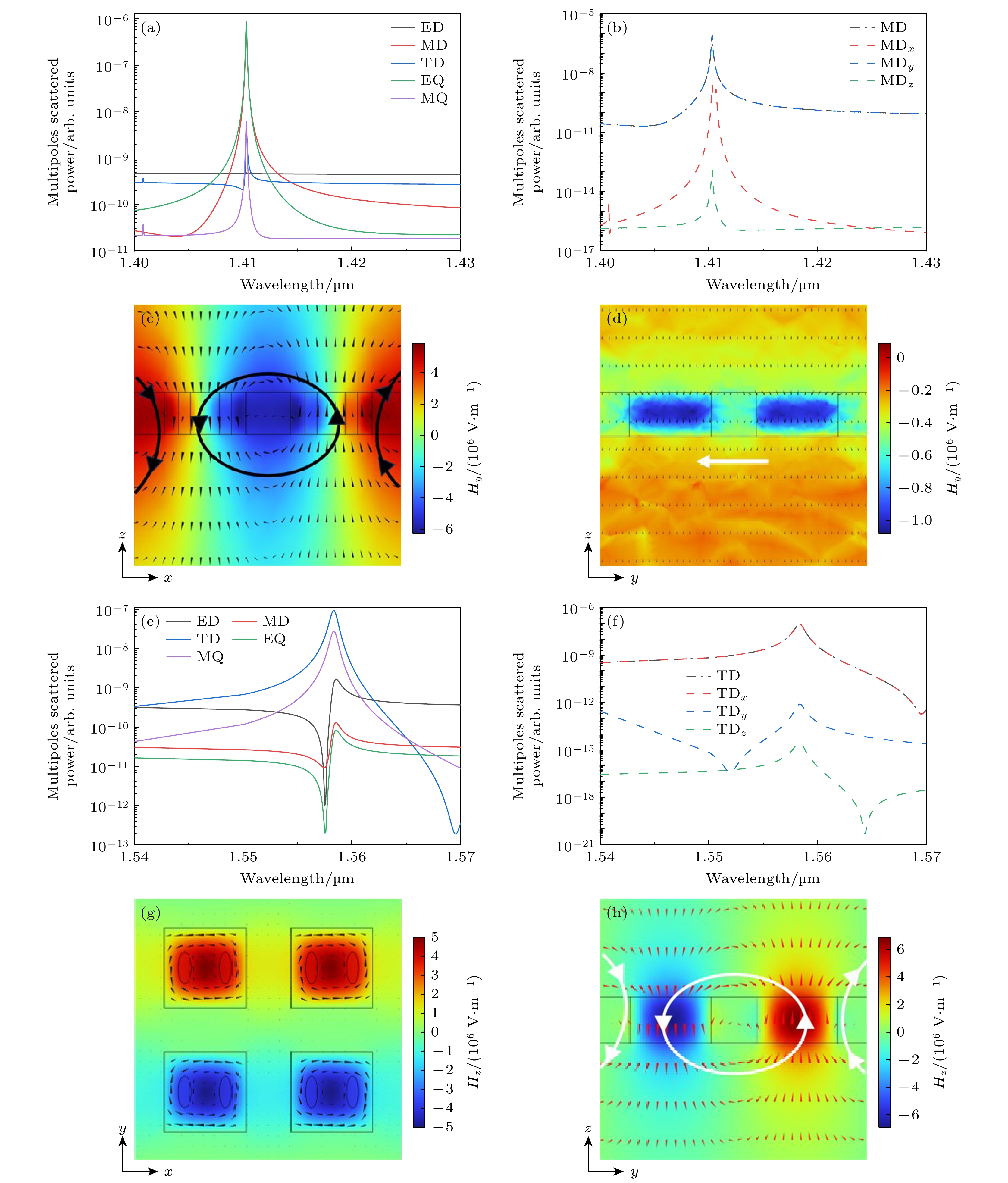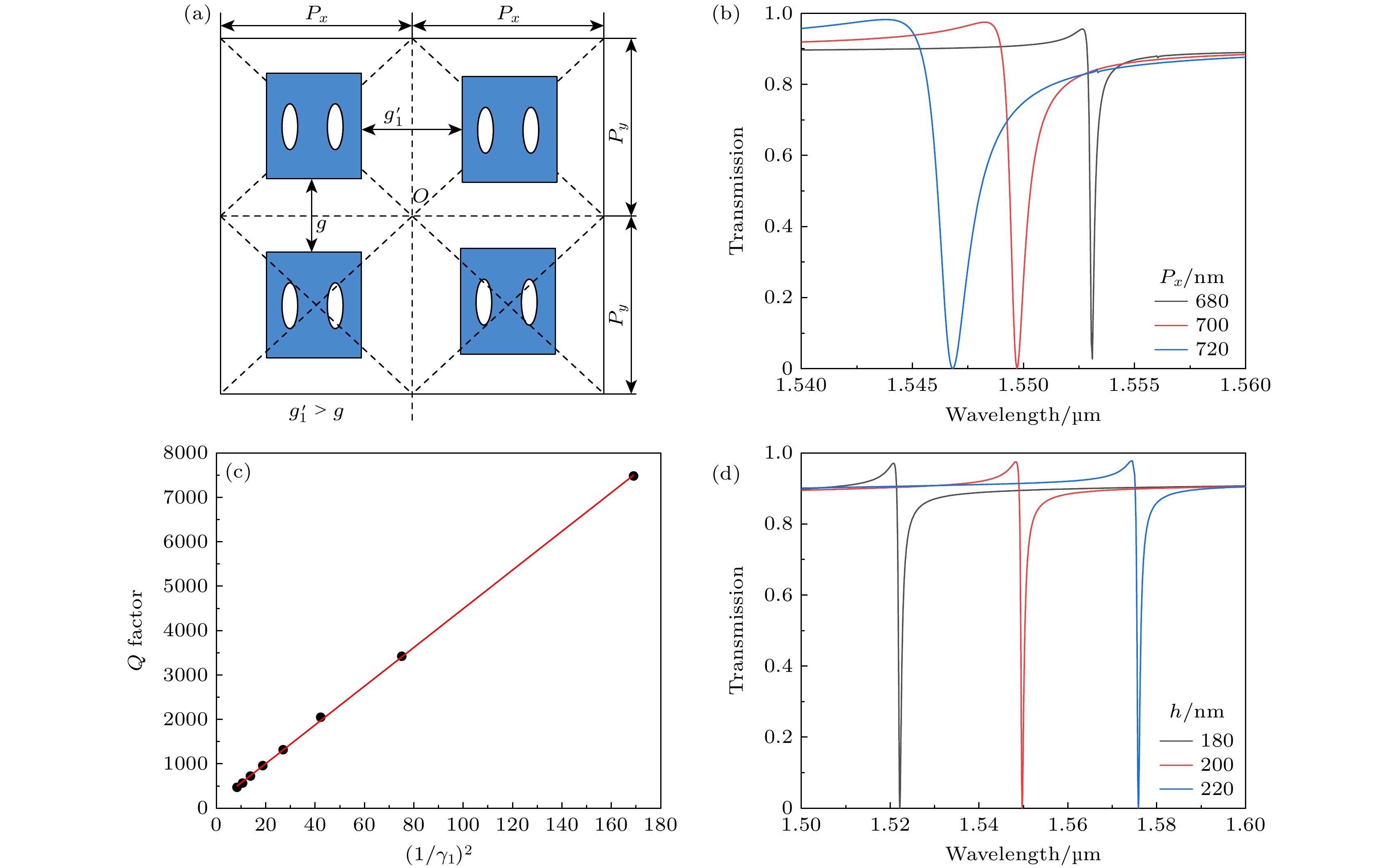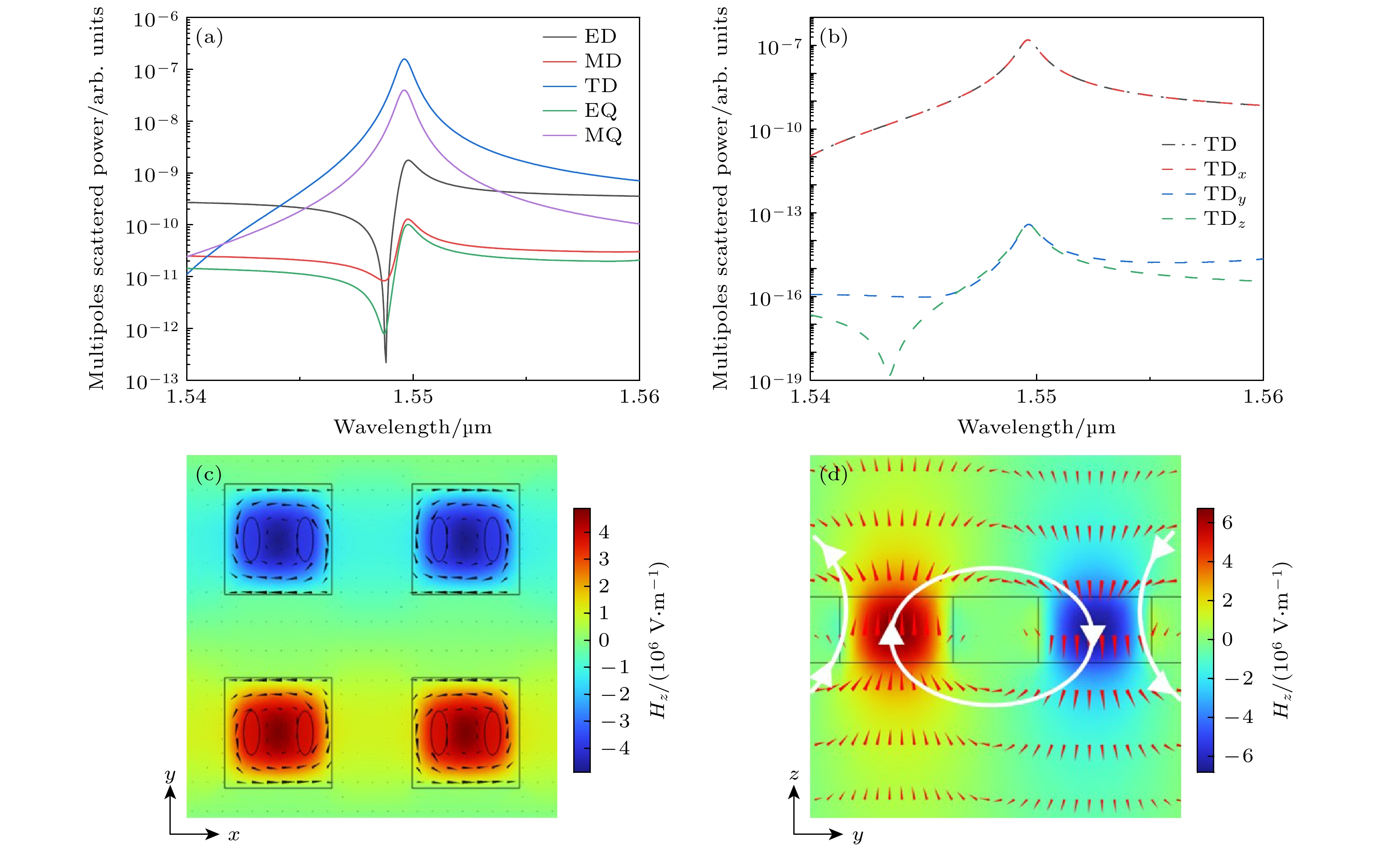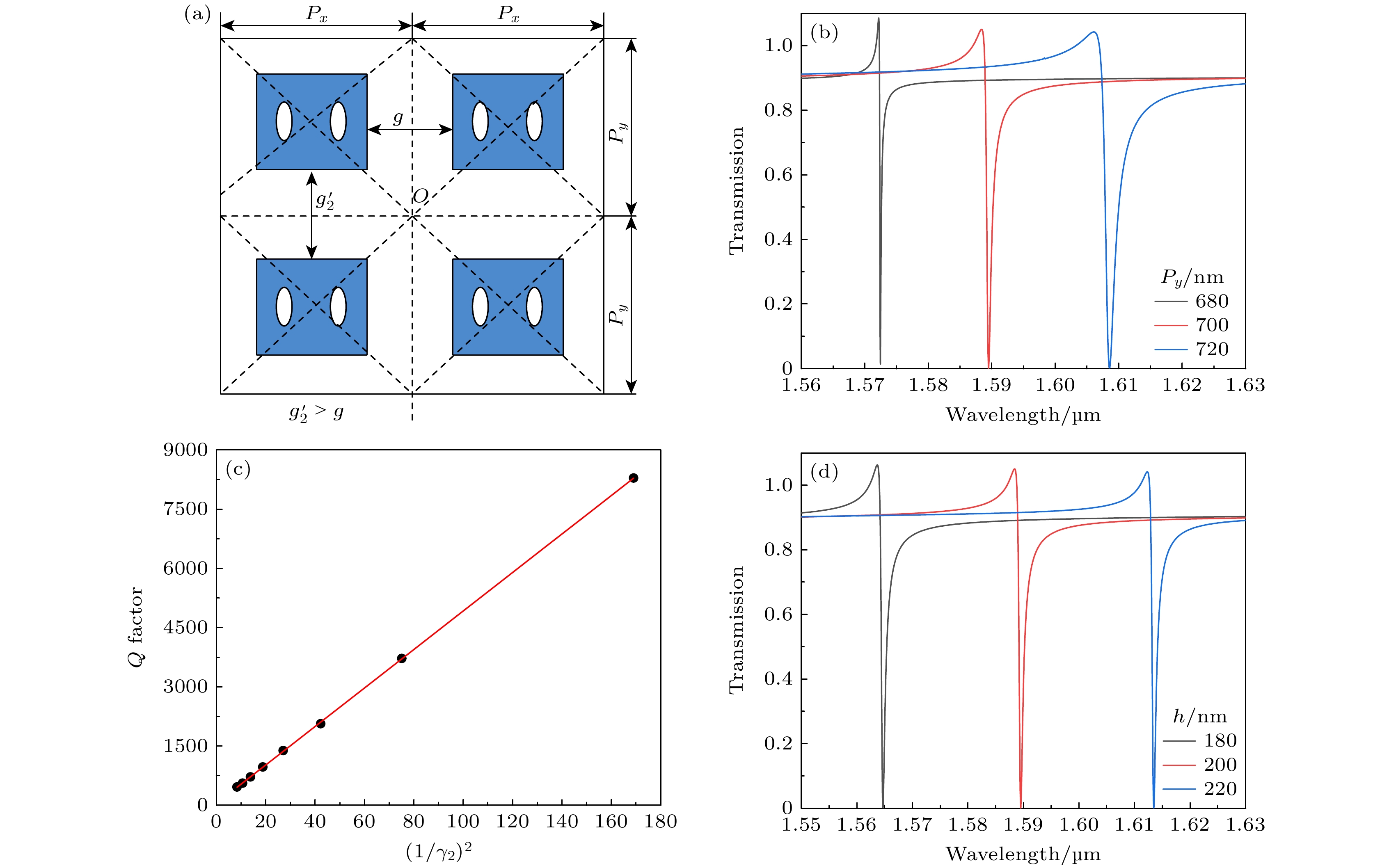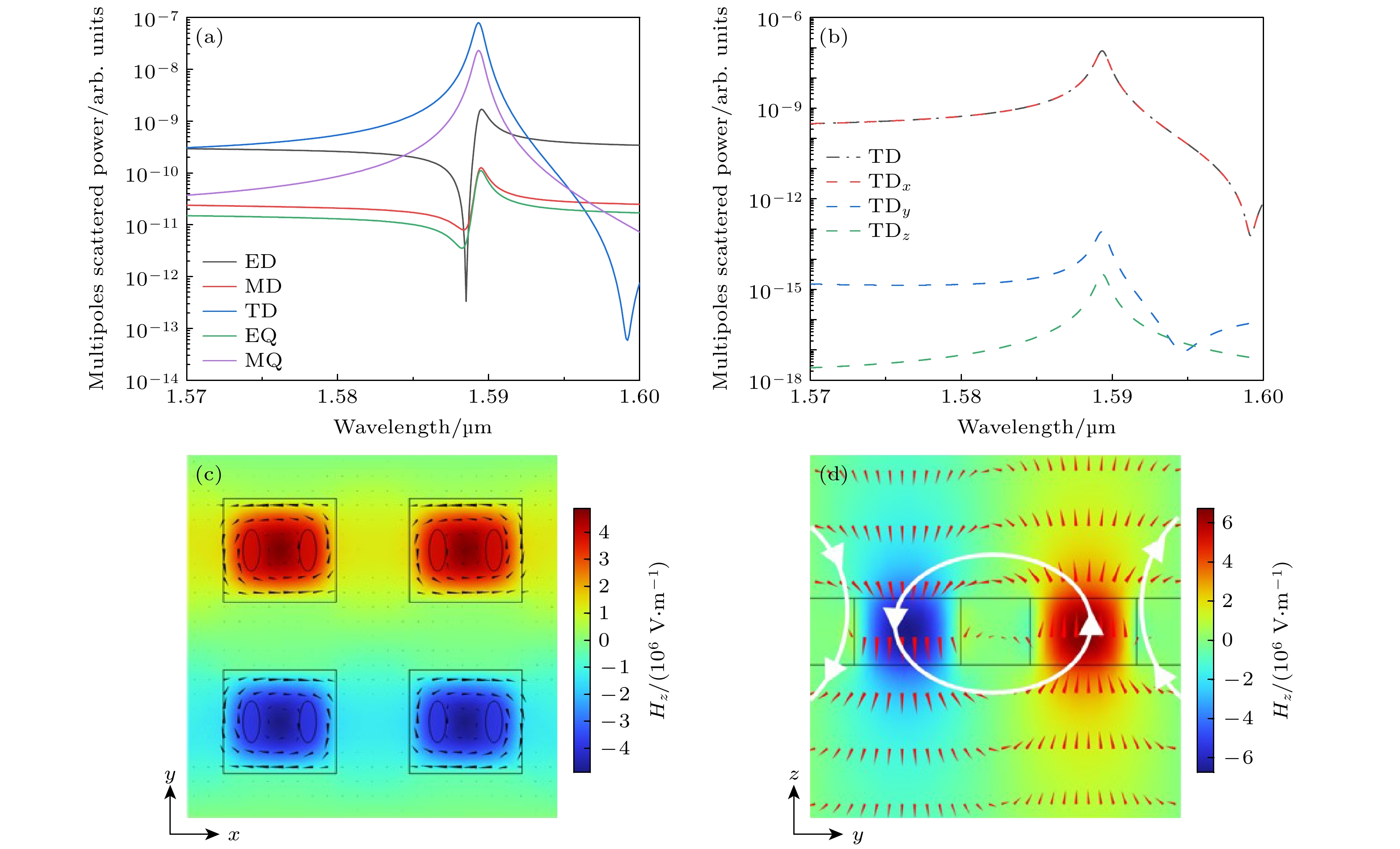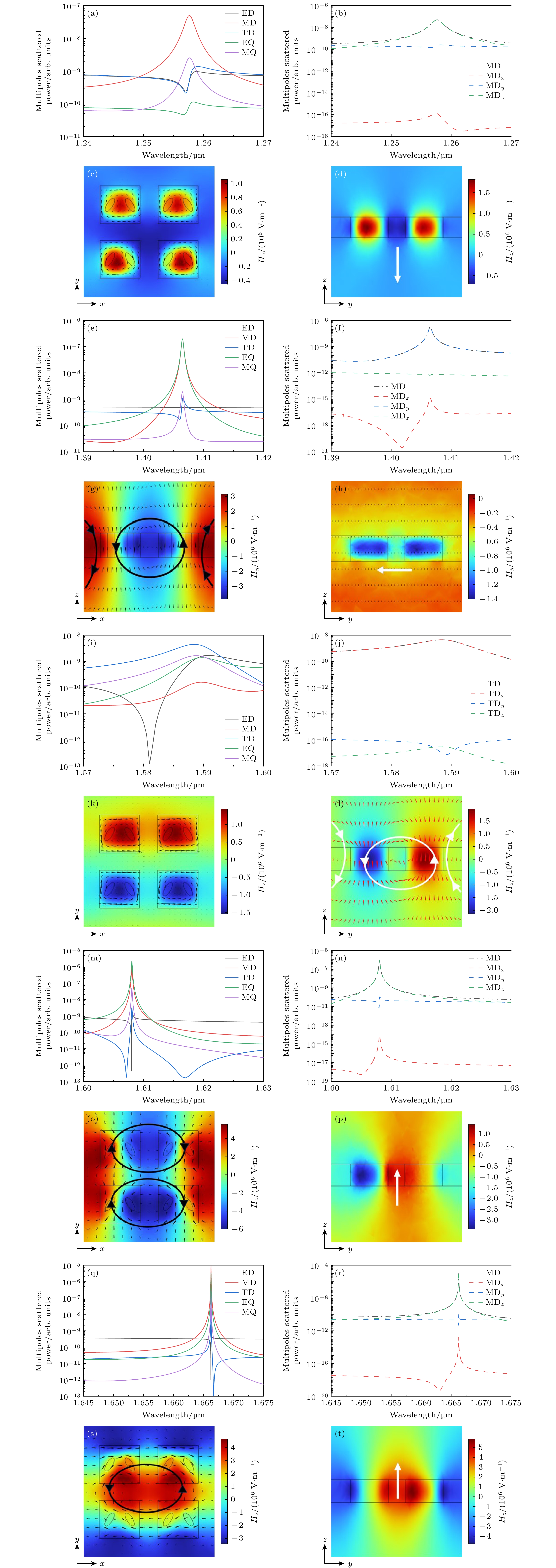-
本文设计了由四聚长方体组成的全介质超表面, 其中每个长方体刻蚀两个椭圆柱并填装空气. 当分别为超表面单独引入面内对称破缺、位移扰动和周期扰动时, 可在近红外波段产生稳健的准连续域束缚态模式(quasi-bound states in the continuum). 通过测量准BIC (quasi-BIC)模式的谐振波长, 计算准BIC模式的Q因子(quality factor)与不对称参数的关系, 可进一步证实不对称参数对准BIC共振频率和Q因子的可调谐性. 在此基础上, 当同时引入面内对称破缺、位移扰动和周期扰动时, 可获得5个高Q因子的准BIC模式. 共振峰的数量、位置以及Q因子都可通过调整面内破缺、位移扰动和周期扰动的程度进行调控. 该超表面的设计可为传感器的多参数传感以及灵敏度等性能的提升提供一种全新思路.High-quality factor (high-Q) resonance has broad prospects in applications such as in narrow-band filtering, slow-light devices, and nonlinear optics interaction enhanced to highly sensitive sensing. Previous methods of designing high-Q resonance suffered intrinsic drawbacks such as high-volume cavities or large-scale bending radii. However, recently, a new approach to designing high-Q resonances has begun to attract public attention on the basis of asymmetric metasurfaces that are related to the bound states in the continuum (BIC) phenomenon. Constructing BIC resonance in electromagnetic metasurface can generate sharp resonant transmission peak. Therefore, there is growing interest in utilizing BIC to achieve metasurface with high-Q. However, most of existing studies are based on single BIC, and few studies focusing on multiband BICs and multiple forms of symmetry breaking. In this work, we propose an all-dielectric metasurface composed of tetrameric cuboids. By etching two elliptical cylinders in each cuboid, the metasurface can simultaneously support in-plane symmetry breaking, displacement perturbations and periodic perturbations. We first use multipole calculations to analyze the physical mechanism by which the metasurface generates quasi-BIC under these three conditions. It is confirmed that the Q factor and resonant peak position of quasi-BIC can be controlled by adjusting the asymmetry parameters. Subsequently, we introduce the in-plane symmetry breaking, displacement perturbations and periodic perturbations into the metasurface simultaneously and generate five quasi-BIC modes, whose numbers and positions can be flexibly adjusted, and the largest Q factor is 58039. In summary, this work provides a new practical design concept for realizing high-Q all-dielectric metasurfaces, which can be used to improve the sensitivity of multi-parameter sensors.
-
Keywords:
- metasurface /
- quasi-bound states in the continuum /
- symmetry breaking
[1] von Neumann J, Wigner E P 1929 Phys. Z. 30 467
[2] Kaelberer T, Fedotov V A, Papasimakis N, Tsai D P, Zheludev N I 2010 Science 330 1510
 Google Scholar
Google Scholar
[3] Plotnik Y, Peleg O, Dreisow F, Heinrich M, Nolte S, Szameit A, Segev M 2011 Phys. Rev. Lett. 107 183901
 Google Scholar
Google Scholar
[4] Hsu C W, Zhen B, Lee J, Chua S L, Johnson S G, Joannopoulos J D, Soljacic M 2013 Nature 499 188
 Google Scholar
Google Scholar
[5] Urseel F 1997 Phys. Eng. Sci. 435 575
[6] Porter R, Evans D V 2005 Wave Motion 43 29
 Google Scholar
Google Scholar
[7] Xiao Y X, Ma G, Zhang Z Q, Chan C T 2017 Phys. Rev. Lett. 118 166803
 Google Scholar
Google Scholar
[8] Retzler C H 2001 Appl. Ocean Res. 23 249
 Google Scholar
Google Scholar
[9] Cobelli P J, Pagneux V, Maurel A, Petitjeans P 2009 Europhys. Lett. 88 20006
 Google Scholar
Google Scholar
[10] Cobelli P J, Pagneux V, Maurel A, Petitjeans P 2011 J. Fluid Mech. 666 445
 Google Scholar
Google Scholar
[11] EVERY A G 2008 Phys. Rev. B 78 174104.
 Google Scholar
Google Scholar
[12] Tittl A, Leitis A, Liu M, Yesilkoy F, Choi D Y, Neshev D N, Kivshar Y S, Altug H 2018 Science 360 1105
 Google Scholar
Google Scholar
[13] Foley J M, Young S M, Phillips J D 2014 Phys. Rev. B 89 165111
 Google Scholar
Google Scholar
[14] Chen S S, Zhang W X, Yang B, Wu T, Zhang X D 2019 Sci. Rep. 9 5551
 Google Scholar
Google Scholar
[15] Zhang Y B, Liu W W, Li Z C, Li Z, Cheng H, Chen S, Tian J G 2018 Opt. Lett. 43 1842
 Google Scholar
Google Scholar
[16] Huo Y Y, Zhang X, Yan M, Sun K, Jiang S Z, Ning T Y, Zhao L N 2022 Opt. Express 30 19030
 Google Scholar
Google Scholar
[17] Yu J B, Ma B Z, OuYang A, Ghosh P, Luo H, Pattanayak A, Kaur S, Qiu M, Belov P, Li Q 2021 Optica 8 1290
 Google Scholar
Google Scholar
[18] Huang L J, Jin R, Zhou C B, et al. 2023 Nat. Commun. 14 3433
 Google Scholar
Google Scholar
[19] Zhou C B, Huang L J, Jin R, et al. 2023 Laser Photonics Rev. 17 2200564
 Google Scholar
Google Scholar
[20] Koshelev K, Lepeshov S, Liu M K, Bogdanov A, Kivshar Y 2018 Phys. Rev. Lett. 121 193903
 Google Scholar
Google Scholar
[21] Mikheeva E, Koshelev K, Choi D Y, Kruk S, Lumeau J, Abdeddaim R, Voznyuk I, Enoch S, Kivshar Y 2019 Opt. Express 27 33847
 Google Scholar
Google Scholar
[22] Chen X, Fan W H 2020 Nanomaterials 10 623
 Google Scholar
Google Scholar
[23] Cai Y P, Huang Y, Zhu K Y, Wu H H 2021 Opt. Lett. 46 4049
 Google Scholar
Google Scholar
[24] 杨磊 2022 硕士学位论文 (北京: 北京邮电大学)
Yang L 2022 M. S. Thesis (Beijing: Beijing University of Posts and Telecommunications
[25] Tang C J, Yan B, Wang Q G, Chen J, Yan Z D, Liu F X, Chen N B, Sui C H 2017 Sci. Rep. 7 582
 Google Scholar
Google Scholar
[26] Jin R, Huang L J, Zhou C B, et al. 2023 Nano Lett. 23 9105
 Google Scholar
Google Scholar
[27] Yu J B, Qin R, Ying Y B, Qiu M, Li Q 2023 Adv. Mat. 35 2302478
 Google Scholar
Google Scholar
[28] Chai R H, Liu W W, Li Z C, Cheng H, Tian J G, Chen S Q 2021 Phys. Rev. B 104 075149
 Google Scholar
Google Scholar
-
图 2 (a)面内破缺后超表面单元平面俯视图; (b)旋转角θ不同时, x偏振光入射对应的透射率曲线; (c)准BIC的Q因子随1/α2的变化曲线; (d)厚度h不同时, x偏振光入射对应的透射率曲线
Fig. 2. (a) Top view of the metasurface unit after in-plane symmetry perturbation; (b) transmittance spectra for x-polarized incident light and different rotation angle θ; (c) Q-factors of QBIC plotted as functions of 1/α2; (d) transmittance spectra for x-polarized incident light and different thickness h.
图 3 (a) x偏振光入射时的多极分解结果, ED, MD, TD, EQ, MQ分别表示电偶极子、磁偶极子、环偶极子、电四极子、磁四极子; (b)磁偶极子的散射功率在x, y, z方向上的分量; (c) x-y平面的电磁场分布; (d) y-z平面的电磁场分布
Fig. 3. (a) Multipole decomposition results during x-polarized normal incidence light, ED, MD, TD, EQ, MQ represent electric dipole, magnetic dipole, toroidal dipole electric, quadrupole and magnetic quadrupole, respectively; (b) x, y and z components of the MD; (c) electromagnetic field distribution in the x-y plane; (d) electromagnetic field distribution in the y-z plane.
图 4 (a)位移扰动后超表面单元平面俯视图; (b)参数Δg不同时, x偏振光入射对应的透射率曲线; (c)准BIC模式1的Q因子随1/β2的变化曲线; (d)准BIC模式2的Q因子随1/β2的变化曲线; (e)厚度h不同时, x偏振光入射对应的透射率曲线
Fig. 4. (a) Top view of the metasurface unit after displacement perturbation; (b) transmittance spectra for x-polarized incident light and different parameters Δg; (c) Q-factors of QBIC mode 1 plotted as functions of 1/β2; (d) Q-factors of QBIC mode 2 plotted as functions of 1/β2; (e) transmittance spectra for x-polarized incident light and different thickness h.
图 5 (a) x偏振光入射时产生的准BIC模式1的多极分解结果; (b)准BIC模式1的磁偶极子的散射功率在x, y, z方向上的分量; (c)准BIC模式1在x-z平面的电磁场分布; (d)准BIC模式1在y-z平面的电磁场分布; (e) x偏振光入射时产生的准BIC模式2的多极分解结果; (f)准BIC模式2的环偶极子的散射功率在x, y, z方向上的分量; (g)准BIC模式2在x-y平面的电磁场分布; (h)准BIC模式2在y-z平面的电磁场分布
Fig. 5. (a) Multipole decomposition results of QBIC mode 1 during x-polarized normal incidence light; (b) components of the MD in the x, y, z directions of QBIC mode 1; (c) electromagnetic field distribution in the x-z plane of QBIC mode 1; (d) electromagnetic field distribution in the y-z plane of QBIC mode 1; (e) multipole decomposition results of QBIC mode 2 during x-polarized normal incidence light; (f) components of the TD in the x, y, z directions of QBIC mode 2; (g) electromagnetic field distribution in the x-y plane of QBIC mode 2; (h) electromagnetic field distribution in the y-z plane of QBIC mode 2.
图 6 (a)当Px > Py时, 超表面单元平面俯视图; (b) Px不同时, x偏振光入射对应的透射率曲线; (c)准BIC模式的Q因子随$ 1/\gamma _2^2 $的变化曲线; (d)厚度h不同时, x偏振光入射对应的透射率曲线
Fig. 6. (a) When Px > Py, the top view of the metasurface unit; (b) transmittance spectra for x-polarized incident light and different Px; (c) Q-factors of QBIC plotted as functions of $ 1/\gamma _2^2 $; (d) transmittance spectra for x-polarized incident light and different thickness h.
图 7 (a) x偏振光入射时的多极分解结果; (b)环偶极子的散射功率在x, y, z方向上的分量; (c) x-y平面的电磁场分布; (d) y-z平面的电磁场分布
Fig. 7. (a) Multipole decomposition results during x-polarized normal incidence light; (b) x, y and z components of the TD; (c) electromagnetic field distribution in the x-y plane; (d) electromagnetic field distribution in the y-z plane.
图 8 (a)当Py > Px时, 超表面单元平面俯视图; (b) Py不同时, x偏振光入射对应的透射率曲线; (c)准BIC模式的Q因子随$ 1/\gamma _2^2 $的变化曲线; (d)厚度h不同时, x偏振光入射对应的透射率曲线
Fig. 8. (a) When Py > Px, the top view of the metasurface unit; (b) transmittance spectra for x-polarized incident light and different Py; (c) Q-factors of QBIC plotted as functions of $ 1/\gamma _2^2 $; (d) transmittance spectra for x-polarized incident light and different thickness h.
图 9 (a) x偏振光入射时的多极分解结果; (b)环偶极子的散射功率在x, y, z方向上的分量; (c) x-y平面的电磁场分布; (d) y-z平面的电磁场分布
Fig. 9. (a) Multipole decomposition results during x-polarized normal incidence light; (b) x, y and z components of the TD; (c) electromagnetic field distribution in the x-y plane; (d) electromagnetic field distribution in the y-z plane.
图 11 (a) x偏振光入射时产生的准BIC模式1的多极分解结果; (b)准BIC模式1的磁偶极子的散射功率在x, y, z方向上的分量; (c)准BIC模式1在x-y平面的电磁场分布; (d)准BIC模式1在y-z平面的电磁场分布; (e) x偏振光入射时产生的准BIC模式2的多极分解结果; (f)准BIC模式2的磁偶极子的散射功率在x, y, z方向上的分量; (g)准BIC模式2在x-z平面的电磁场分布; (h)准BIC模式2在y-z平面的电磁场分布; (i) x偏振光入射时产生的准BIC模式3的多极分解结果; (j)准BIC模式3的环偶极子的散射功率在x, y, z方向上的分量; (k)准BIC模式3在x-y平面的电磁场分布; (l)准BIC模式3在y-z平面的电磁场分布; (m) x偏振光入射时产生的准BIC模式4的多极分解结果; (n)准BIC模式4的磁偶极子的散射功率在x, y, z方向上的分量; (o)准BIC模式4在x-y平面的电磁场分布; (p)准BIC模式4在y-z平面的电磁场分布; (q) x偏振光入射时产生的准BIC模式5的多极分解结果; (r)准BIC模式5的磁偶极子的散射功率在x, y, z方向上的分量; (s)准BIC模式5在x-y平面的电磁场分布; (t)准BIC模式5在y-z平面的电磁场分布
Fig. 11. (a) Multipole decomposition results of QBIC mode 1 during x-polarized normal incidence light; (b) Components of the MD in the x, y, z directions of QBIC mode 1; (c) electromagnetic field distribution in the x-y plane of QBIC mode 1; (d) electromagnetic field distribution in the y-z plane of QBIC mode 1; (e) multipole decomposition results of QBIC mode 2 during x-polarized normal incidence light; (f) components of the MD in the x, y, z directions of QBIC mode 2; (g) electromagnetic field distribution in the x-z plane of QBIC mode 2; (h) electromagnetic field distribution in the y-z plane of QBIC mode 2; (i) multipole decomposition results of QBIC mode 3 during x-polarized normal incidence light; (j) components of the TD in the x, y, z directions of QBIC mode 3; (k) electromagnetic field distribution in the x-y plane of QBIC mode 3; (l) Electromagnetic field distribution in the y-z plane of QBIC mode 3; (m) multipole decomposition results of QBIC mode 4 during x-polarized normal incidence light; (n) components of the MD in the x, y, z directions of QBIC mode 4; (o) electromagnetic field distribution in the x-y plane of QBIC mode 4; (p) electromagnetic field distribution in the y-z plane of QBIC mode 4; (q) Multipole decomposition results of QBIC mode 5 during x-polarized normal incidence light; (r) components of the MD in the x, y, z directions of QBIC mode 5; (s) electromagnetic field distribution in the x-y plane of QBIC mode 5; (t) electromagnetic field distribution in the y-z plane of QBIC mode 5.
-
[1] von Neumann J, Wigner E P 1929 Phys. Z. 30 467
[2] Kaelberer T, Fedotov V A, Papasimakis N, Tsai D P, Zheludev N I 2010 Science 330 1510
 Google Scholar
Google Scholar
[3] Plotnik Y, Peleg O, Dreisow F, Heinrich M, Nolte S, Szameit A, Segev M 2011 Phys. Rev. Lett. 107 183901
 Google Scholar
Google Scholar
[4] Hsu C W, Zhen B, Lee J, Chua S L, Johnson S G, Joannopoulos J D, Soljacic M 2013 Nature 499 188
 Google Scholar
Google Scholar
[5] Urseel F 1997 Phys. Eng. Sci. 435 575
[6] Porter R, Evans D V 2005 Wave Motion 43 29
 Google Scholar
Google Scholar
[7] Xiao Y X, Ma G, Zhang Z Q, Chan C T 2017 Phys. Rev. Lett. 118 166803
 Google Scholar
Google Scholar
[8] Retzler C H 2001 Appl. Ocean Res. 23 249
 Google Scholar
Google Scholar
[9] Cobelli P J, Pagneux V, Maurel A, Petitjeans P 2009 Europhys. Lett. 88 20006
 Google Scholar
Google Scholar
[10] Cobelli P J, Pagneux V, Maurel A, Petitjeans P 2011 J. Fluid Mech. 666 445
 Google Scholar
Google Scholar
[11] EVERY A G 2008 Phys. Rev. B 78 174104.
 Google Scholar
Google Scholar
[12] Tittl A, Leitis A, Liu M, Yesilkoy F, Choi D Y, Neshev D N, Kivshar Y S, Altug H 2018 Science 360 1105
 Google Scholar
Google Scholar
[13] Foley J M, Young S M, Phillips J D 2014 Phys. Rev. B 89 165111
 Google Scholar
Google Scholar
[14] Chen S S, Zhang W X, Yang B, Wu T, Zhang X D 2019 Sci. Rep. 9 5551
 Google Scholar
Google Scholar
[15] Zhang Y B, Liu W W, Li Z C, Li Z, Cheng H, Chen S, Tian J G 2018 Opt. Lett. 43 1842
 Google Scholar
Google Scholar
[16] Huo Y Y, Zhang X, Yan M, Sun K, Jiang S Z, Ning T Y, Zhao L N 2022 Opt. Express 30 19030
 Google Scholar
Google Scholar
[17] Yu J B, Ma B Z, OuYang A, Ghosh P, Luo H, Pattanayak A, Kaur S, Qiu M, Belov P, Li Q 2021 Optica 8 1290
 Google Scholar
Google Scholar
[18] Huang L J, Jin R, Zhou C B, et al. 2023 Nat. Commun. 14 3433
 Google Scholar
Google Scholar
[19] Zhou C B, Huang L J, Jin R, et al. 2023 Laser Photonics Rev. 17 2200564
 Google Scholar
Google Scholar
[20] Koshelev K, Lepeshov S, Liu M K, Bogdanov A, Kivshar Y 2018 Phys. Rev. Lett. 121 193903
 Google Scholar
Google Scholar
[21] Mikheeva E, Koshelev K, Choi D Y, Kruk S, Lumeau J, Abdeddaim R, Voznyuk I, Enoch S, Kivshar Y 2019 Opt. Express 27 33847
 Google Scholar
Google Scholar
[22] Chen X, Fan W H 2020 Nanomaterials 10 623
 Google Scholar
Google Scholar
[23] Cai Y P, Huang Y, Zhu K Y, Wu H H 2021 Opt. Lett. 46 4049
 Google Scholar
Google Scholar
[24] 杨磊 2022 硕士学位论文 (北京: 北京邮电大学)
Yang L 2022 M. S. Thesis (Beijing: Beijing University of Posts and Telecommunications
[25] Tang C J, Yan B, Wang Q G, Chen J, Yan Z D, Liu F X, Chen N B, Sui C H 2017 Sci. Rep. 7 582
 Google Scholar
Google Scholar
[26] Jin R, Huang L J, Zhou C B, et al. 2023 Nano Lett. 23 9105
 Google Scholar
Google Scholar
[27] Yu J B, Qin R, Ying Y B, Qiu M, Li Q 2023 Adv. Mat. 35 2302478
 Google Scholar
Google Scholar
[28] Chai R H, Liu W W, Li Z C, Cheng H, Tian J G, Chen S Q 2021 Phys. Rev. B 104 075149
 Google Scholar
Google Scholar
计量
- 文章访问数: 7188
- PDF下载量: 281
- 被引次数: 0













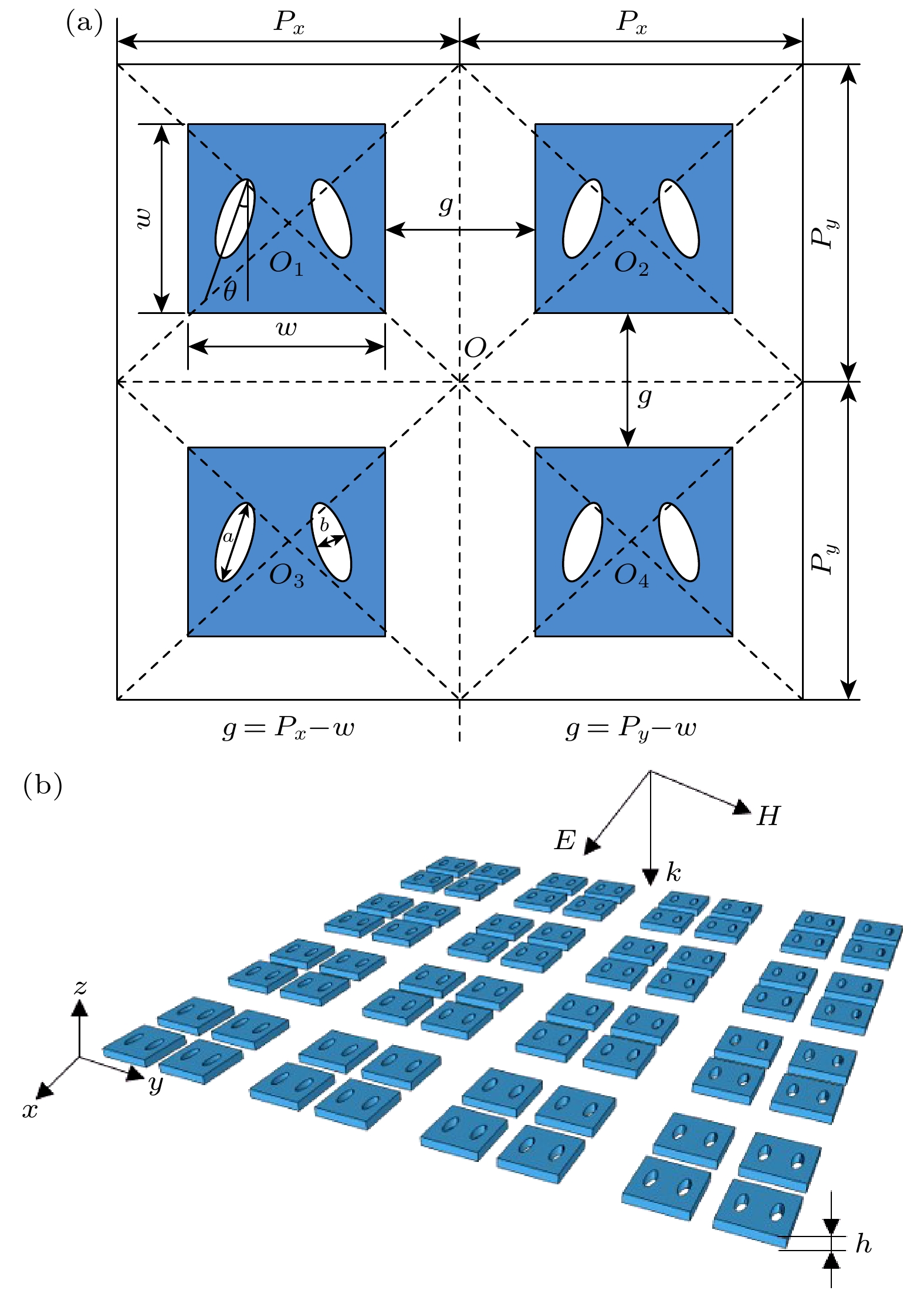
 下载:
下载:
